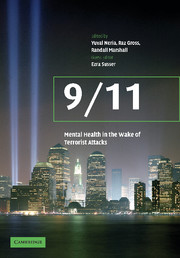Book contents
- Frontmatter
- Contents
- Acknowledgments
- Editors brief bio
- List of contributors
- Foreword
- Part I Introduction
- Part II The psychological aftermath of 9/11
- Part III Reducing the burden: community response and community recovery
- 9 Community and ecological approaches to understanding and alleviating postdisaster distress
- 10 What is collective recovery?
- 11 Rebuilding communities post-disaster in New York
- 12 Journalism and the public during catastrophes
- 13 Effective leadership in extreme crisis
- 14 Guiding community intervention following terrorist attack
- Part IV Outreach and intervention in the wake of terrorist attacks
- Part IV A New York area
- Part IV B Washington, DC
- Part IV C Prolonged-exposure treatment as a core resource for clinicians in the community: dissemination of trauma knowledge post-disaster
- Part V Disasters and mental health: perspectives on response and preparedness
- Index
11 - Rebuilding communities post-disaster in New York
from Part III - Reducing the burden: community response and community recovery
Published online by Cambridge University Press: 27 October 2009
- Frontmatter
- Contents
- Acknowledgments
- Editors brief bio
- List of contributors
- Foreword
- Part I Introduction
- Part II The psychological aftermath of 9/11
- Part III Reducing the burden: community response and community recovery
- 9 Community and ecological approaches to understanding and alleviating postdisaster distress
- 10 What is collective recovery?
- 11 Rebuilding communities post-disaster in New York
- 12 Journalism and the public during catastrophes
- 13 Effective leadership in extreme crisis
- 14 Guiding community intervention following terrorist attack
- Part IV Outreach and intervention in the wake of terrorist attacks
- Part IV A New York area
- Part IV B Washington, DC
- Part IV C Prolonged-exposure treatment as a core resource for clinicians in the community: dissemination of trauma knowledge post-disaster
- Part V Disasters and mental health: perspectives on response and preparedness
- Index
Summary
What happened on September 11th?
Most clinicians and mental health professionals would say that what happened on September 11, 2001, was a terrorist attack that traumatized people at rates relative to their exposure to the event. Based on this assumption, the mental health system enumerated symptoms and mobilized resources for individual treatment. This was the driving logic of post-disaster response and it led to an investment of millions of dollars in a narrowly defined effort to treat the trauma suffered by individuals.
But we hope to argue here that, on 9/11, a keystone urban neighborhood was destroyed, an act that threatened the health and well-being of the New York metropolitan region, as well as the nation. Based on this assumption, an array of actions were required that would serve to re-knit the social, economic, and cultural linkages of the city, the region and the nation. This approach, though a minor part of the early disaster relief, is an essential component of long-term urban rehabilitation. We assert that the nature of long-term recovery will be influenced by the degree to which re-knitting interventions are ultimately instituted.
In this chapter, we will describe the rational for community-level interventions, and we will illustrate these ideas using examples from our work in Lower Manhattan and in the larger region.
What is a keystone?
Perhaps the central concept in the argument we are making is that of a “keystone,” a concept that ecologists adopted from architects to describe the entity that gives stability to a complex system, similar to the manner in which a keystone gives stability to an arch. Urban ecologists have noted a keystone neighborhood will affect the well-being of the city and even the region within which the neighborhood is embedded (Fullilove, 1999-2000).
- Type
- Chapter
- Information
- 9/11: Mental Health in the Wake of Terrorist Attacks , pp. 164 - 177Publisher: Cambridge University PressPrint publication year: 2006
- 3
- Cited by



